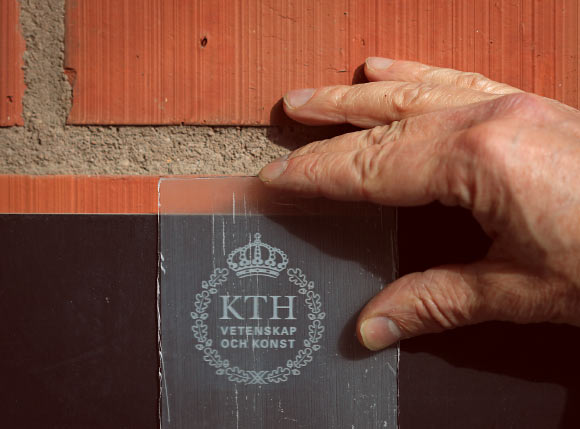A team of scientists at KTH Royal Institute of Technology in Stockholm, Sweden, has developed transparent wood that could be used in building materials and could help home and building owners save money on their artificial lighting costs. This material, reported in the journal Biomacromolecules, also could find application in solar cell windows.

A close-up look at the transparent wood created by Dr. Lars Berglund and co-authors. Image credit: KTH Royal Institute of Technology.
Homeowners often search for ways to brighten up their living space. They opt for light-colored paints, mirrors and lots of lamps and ceiling lights. But if the walls themselves were transparent, this would reduce the need for artificial lighting.
Recent work on making transparent paper from wood has led to the potential for making similar but stronger materials.
Dr. Lars Berglund of the KTH Royal Institute of Technology’s Wallenberg Wood Science Center and his colleagues wanted to pursue this possibility.
“Transparent wood panels can be used for windows, and semitransparent facades, when the idea is to let light in but maintain privacy,” Dr. Berglund said.
“Transparent wood is also a good material for solar cells, since it’s a low-cost, readily available and renewable resource. This becomes particularly important in covering large surfaces with solar cells.”
“The optically transparent wood is a type of wood veneer in which the lignin is removed chemically,” he said.
The scientists removed the lignin – a structural polymer in plants that blocks 80 to 95% of light from passing through – from samples of commercial balsa wood. But the resulting material was still not transparent due to light scattering within it.
To allow light to pass through the wood more directly, they incorporated poly(methyl methacrylate), also known as acrylic or Plexiglas. They could see through the resulting material, which was twice as strong as Plexiglas.
“Although the wood isn’t as crystal clear as glass, its haziness provides a possible advantage for solar cells,” the scientists said.
“Specifically, because the material still traps some light, it could be used to boost the efficiency of these cells.”
“Among the work to be done next is enhancing the transparency of the material and scaling up the manufacturing process,” Dr. Berglund said.
“We also intend to work further with different types of wood.”
_____
Yuanyuan Li et al. Optically Transparent Wood from a Nanoporous Cellulosic Template: Combining Functional and Structural Performance. Biomacromolecules, published online March 4, 2016; doi: 10.1021/acs.biomac.6b00145



![Chemical structure of the cyclo[48]carbon [4]catenan. Image credit: Harry Anderson.](https://cdn.sci.news/images/2025/08/image_14141-Cyclo-48-Carbon-104x75.jpg)


